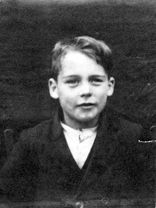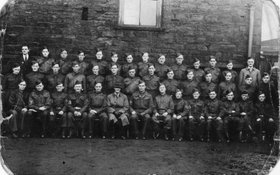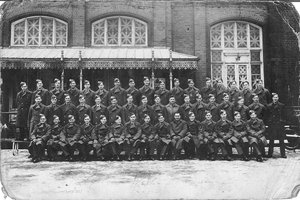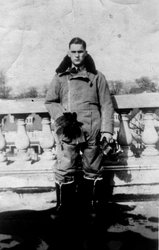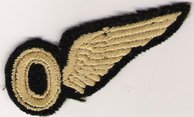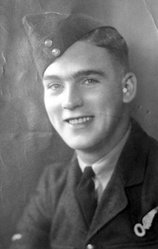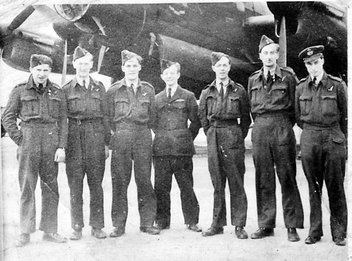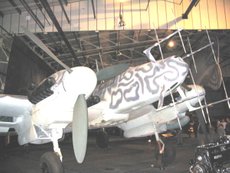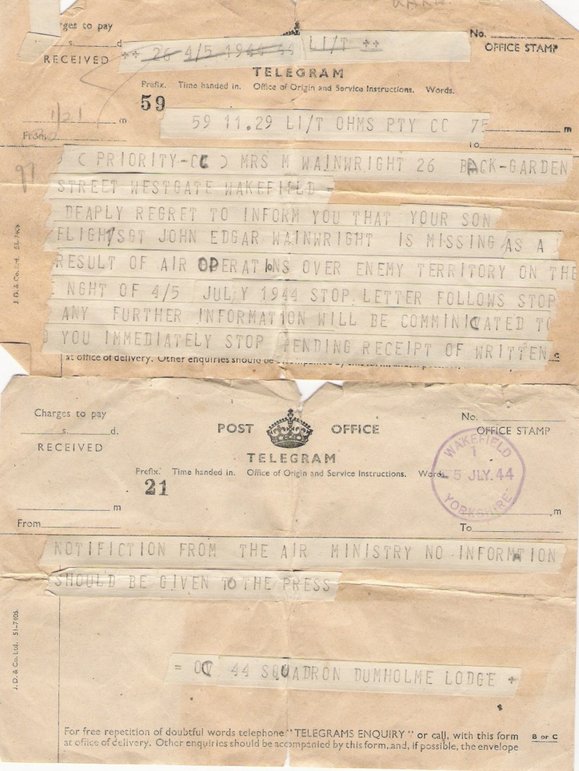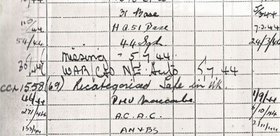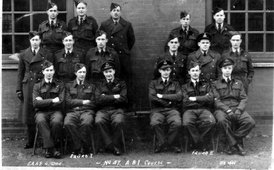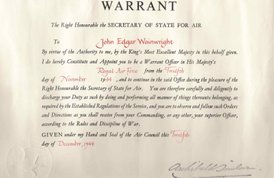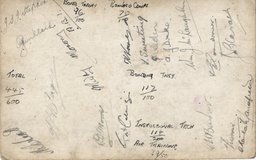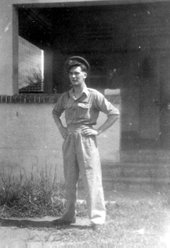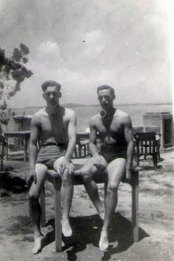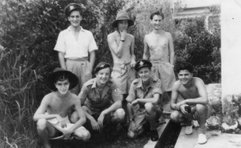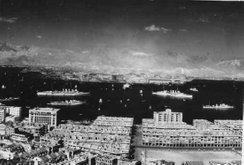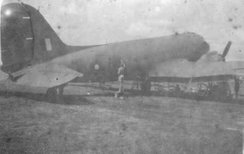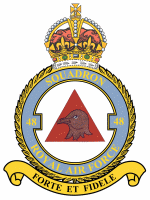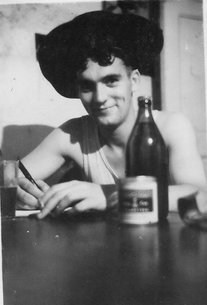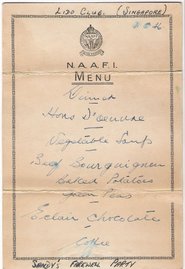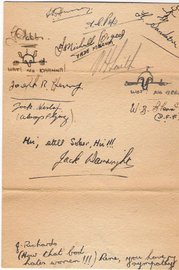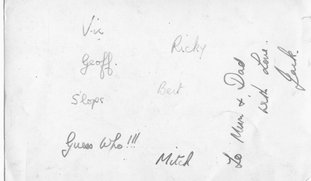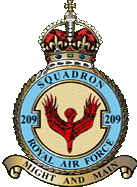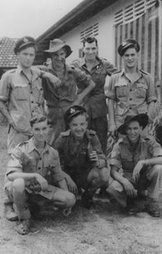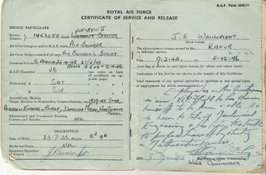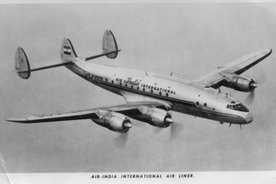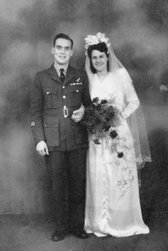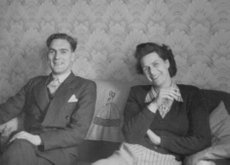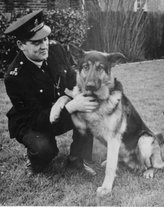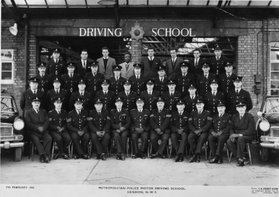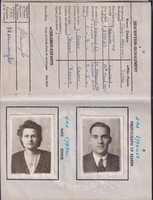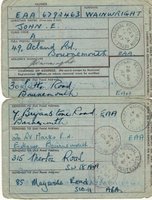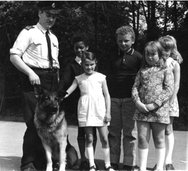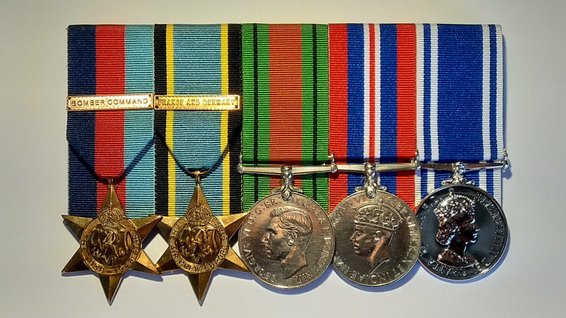Lancaster ME699 - A Bomber crew at war
Warrant Officer John Edgar Wainwright, RAF
Early Years
My Father, John Edgar Wainwright, always known as Jack, was born on the 23rd July 1923, the son of a miner, in a village called Stanley near Wakefield in Yorkshire. He was a bright lad, but the family could not afford the grammar school uniform so at the first opportunity he was shipped out to start work.
Rather than the mines though, he joined the railways and worked as an engine cleaner. He was 16 when war was declared and not yet eligible for military service. When the Home Guard was formed in 1940 he joined the local platoon.
Joining the RAF
As soon as he was old enough he joined the RAF, on the 29th July 1941, six days after his 18th birthday and reported to RAF Cardington near Bedford. He was classified Medical Category Grade 1 and earmarked for pilot training when he was 18 and three months and put on Reserve. I have a photocopy of Jack's RAF records sent to me by the Ministry of Defence in 1993 which can be viewed here along with my best interpretations of what the various postings were.
All aircrew were volunteers, and by that stage of the war my Dad must have known full well that the odds were that a good proportion of aircrew did not survive. Accepted figures now are that 55% were killed, while something only just over a quarter survived a tour of 30 operations without being killed, severely injured, captured or shot down. Bomber Command lost a total of 55,573 men in WWII.
Jack was recalled from reserve on the 9th of February 1942 and reported to the Air Crew Reception Centre (I believe at Lords Cricket Ground in London) and from there was posted to 4 ITW at Paignton in Devon for pilot training.
Jack failed his pilot training which took place between the end of February and May 1942 and by August 1942 was remustered into training as a bomb aimer (or Air Bomber). Rob Davis says at RAF Bomber Command 1939-45 "Everyone wanted to be a pilot and those who failed the aptitude and preliminary flying tests were remustered as navigators and bomb aimers."
Training for the three key personnel on a bomber, pilot, navigator and bomb aimer, was two years. Jack's RAF record shows a series of postings to various training units through 1942 and 1943 including six months spent in South Africa where he also attended an Air Navigation course.
Despite all the photos showing him wearing an observers badge (winged "O"), and this being the one I found with his documents from the RAF (left), dad is credited with having an Air Bombers Brevet rather than being an "Observer", a role that was discontinued in 1942. As noted above, he had trained in both navigation and bombing in South Africa, the disciplines for an observer.
Prior to the introduction of the PNB (Pilot/Nav/Bomb Aimer) scheme all observers were trained to navigate and drop bombs and were awarded the 'Winged O'. Normally after that point trainees only received training in one of these skills and therefore received either the 'N' or 'B' brevet. After their introduction Observers were 'supposed' to specialise in one or the other and wear the appropriate badge, however many chose not to and keep the 'O' badge. Some COs insisted on the new badges, others didn't, it was one of those anomalies that creep into the system. (Information provided by Malcolm Barrass - Air of Authority)
Jack was posted to 82OTU (Ossington - September to November 1943)) and there he was crewed together with Aussie pilot Bill Young, navigator from London Frank Wareham, and fellow Tyke's Thomas Jackson (W/Op) and Bob Routledge (AG). At 1657HCU (Stradishall - February 44) and 5LFS (Waterbeach - March 44) the five became seven with the addition of Bill Robinson and Canadian, Bill Rennie. In late March 1944 the crew was was finally posted to No. 51 Base (Swinderby) qualified for allocation to a squadron.
Bill Young's crew was posted to No 44 (Rhodesia) Squadron stationed at Dunholme Lodge in Lincolnshire on the 24th March 1944. No 44 (Rhodesia) Squadron was part of 5 Group, Bomber Command, and back in December 1941 had been the first squadron to be equipped with the Avro Lancaster.
Left to right: Flight Engineer Sgt William (Bill) Robinson, Wireless Operator Sgt Thomas (Leslie) Jackson, Bomb Aimer F Sgt John (Jack) Wainwright, Pilot Officer William (Bill) Young RAAF, Rear Gunner Sgt Robert (Bob) Routledge, Mid Upper Gunner F Sgt William (Bill) Rennie RCAF and Flying Officer Frank Wareham, Navigator.
Not pictured from the crew lost on the 4th/5th July are Flying Officer Harold Braathen RCAF, who was a second navigator, flying for experience on that particular night, and Rear Gunner Sgt Ronald Houseman who took over from the regular rear gunner, Bob Routledge when he was taken ill shortly before the aircraft took off.
KM-T Shot Down
On the night of 4th July the crew of Lancaster Mark I ME699, designated KM-T for Tommy, took off from Dunholme Lodge at 23:00 as part of the raid on St Leu d'Esserent.
It is believed that KM-T was the fifth Lancaster downed by German night fighters on the raid on St Leu d'Esserant when it was shot down by a ME 110 night-fighter over Beauvais. The German night fighter claim for KM-T states the time of the kill as 01:49 on the 5th of July 1944, and names the pilot of the aircraft as Unteroffizier Günther S. Schlomberg (also see Kracker Luftwaffe archive)..
Schlomberg was with 3./NJG3, a night-fighter unit based in Vechta in northern Germany. German controllers had directed the night-fighters to the channel on detecting the raid coming in and the fighters followed the bomber stream across France and towards their target. At some point after the St Leu bombers attacked their target and turned for home Schlomberg attacked KM-T while it was flying at 2,500m above Beauvais.
With ME699 fatally hit by Schlomberg's night fighter shortly after dropping its load of 1,000lb bombs on target, the pilot, PO Bill Young ordered the crew to abandon the aircraft. The hatch at the front of the Lancaster was right below the bomb aimer's position and on such an order the bomb aimers job was to open the hatch and get the hell out, making space for the rest of the crew.
Jack was first out, followed by the flight engineer Sergeant Bill Robinson, then wireless operator Sergeant Leslie Jackson before the plane plunged to the ground and exploded, killing the other five men on board. Leslie Jackson also did not survive bailing out for a reason unknown. This is described in a 1946 letter to Harold Braathen's family from the RCAF published here.
Having landed behind enemy lines Jack was lucky that he was in "friendly" territory. The invasion of Europe was established in Normandy after D-Day and the French Resistance were actively supporting from behind German lines.
His IS9 Evasion Report shows that he quickly met with a local boy who had already picked up the other survivor, Bill Robinson and headed with him towards Bresles. They hid overnight in farm buildings and were then picked up by a policeman from Bresles, probably a Mr Jean Roudiere, and taken to the police station to be kept safe.
The following morning his mother in Wakefield received the dreaded "Missing" telegram.
My Father spent most of July and August 1944 in France with the French Resistance. This section has now grown to the point it needs it's own page!
Back in the UK
Having been returned to the Allies by the French Resistance he was sent back to the UK, and debriefed on his time in France by IS9. The report on this debrief, marked "Secret" at the time, is now in the National Archives, and is dated 4th September 1944.
Following this he was and given leave to go home to Wakefield. For whatever reason, the telegram telling his family he was safe and well (below) did not get sent until the 9th of September, by which time he was already home.
Dad used to tell the story of knocking on his mother's door and her opening it to find the son she must have thought was dead by that point standing there. There was no dramatic scene though, this was Yorkshire! His mother just said, "Hello John" and invited him in for a cup of tea.
After a period of leave Jack returned to duty and was posted to RAF Manby in January 1945, where he attended No 47 ABI course to qualify as an instructor at the Air Armament School at the base.
He was also promoted to Warrant Officer around this time fur the duration. He transferred to 5 Air Navigation School at RAF Jurby on the Isle of Man when this was formed in May 1945.
The Warrant is dated earlier than the above picture although Jack is clearly wearing Flight Sergeant's stripes above. The promotion was probably backdated.
While he was at RAF Jurby, Dad met Bob Routledge in a cinema purely by chance and they shared a few beers catching up on what had happened to Bill Young's crew. Bob was at the time stationed as an instructor at another training school on the island, at RAF Andreas.
With the war over both in Europe and the Far East, his next posting was to RAF Dunkeswell, near Exeter, in November 1945 which was a Ferry Unit preparing aircraft for overseas service.
The Far East
In February 1946 Jack was posted to HQ 232 group, part of Air Command South East Asia (ACSEA) and in March 1946 on to 48 Squadron based at Changi in Singapore as an Air Quartermaster, flying on Dakota's, and also with 209 Squadron on Sunderland Flying Boats and saw much of the region from India to Australia.
From the photographs below this was mainly through the bottom of a beer glass!
After the RAF
The records seem to show that Jack was dropped to LAC and employed as an Air Movements Assistant, which is a ground based job at the end of hostilities. Having trained it would make sense to re-assign him to aircrew as an Air Quartermaster in the rank of Sergeant which seems to have been his role with 48 Squadron. At the end of 1946 the rank of Sergeant was scrapped in the RAF for aircrew and recategorised Aircrew II. The release seems to have been filled in Warrant Officer by mistake and amended at a later date.
Malcolm Barrass (Air of Authority) says: At the end of WWII there were hundreds of W/Os and Flt Sgts employed as drivers and on other non-aircrew duties. During the day they were required to cover their rank badges and act as normal airmen but at meal times and after work they were allowed to return to the Sergeant's Mess. Officers were not exempt, Group Captains could find themselves back down to Flight Lieutenant and it took them another 20 years to regain their wartime ranks.
Jack was released by the RAF in January 1947 and returned to civvy street working still with aircraft as part of Air India's London operation.
He married my mother, who he had met in the RAF when she was a WAAF Radio Operator at RAF Binbrook and later RAF Blyton, while on demob leave on the 8th February 1947 in Bournemouth. I have a number of pictures from my mother's time as a WAAF at these bases that can be found on my Mum's page.
The slightly strained look is due to the weather on the day. The winter of 1947 was memorably one of the coldest ever and the day was so bad they had to have pictures taken in a studio. Dad is clearly wearing a Warrant Officer's uniform in this picture.
After some time working for Air India, in 1954 he joined the Metropolitan Police and was posted to a beat in Chelsea in West London, where we lived in a Police flat in Wray House in Elystan Street.
He loved being given football duty and was a big fan of Fulham in the days of Johnny Haynes - that was in the days before hooliganism raised its head.
My parents had two children, my sister Christine, born in 1954 and Michael (me) in 1960.
With the expansion of Greater London in 1964, and the Metropolitan Police taking over the new outer London Boroughs dad moved the family to Essex to live and work in Rainham, to give us some space and a better quality of life outside inner London.
His new station ID at Rainham? KM, the same as 44 (Rhodesia) Squadron! Co-incidence? Who knows!
Dad remained a PC until he retired in the summer of 1978, latterly having been a
police dog handler.
Throughout his police career he steadfastly refused to take the Sergeants exams or
lean on the influence of his brother-in-law, Mum's brother Frederick (Dick) Sheppard, who reached the rank of Deputy Assistant Commissioner in the Metropolitan Police.
Dick is pictured in my mum's photos.whole serving in the Tank regiment in Italy
where he won the Military Cross. He also was awarded the Queen's Police Medal
in January 1970.
Dad served long enough to add the Police Long Service and Good Conduct Medal to his ribbon although this was sadly presented to my mum after his death.
Tragically, between his retirement from the police and taking up a new job dad was diagnosed as suffering from cancer, a result of 36 years of smoking, a habit picked up while in the RAF. After a short fight with the big C he died on Friday the 13th of October 1978 in Oldchurch Hospital, Romford, aged just 55.
Despite having officially retired he was given a full police funeral which took place at Upminster Crematorium in Essex and he is commemorated in the main chapel at the Crematorium
He is still missed by all that knew him.
The years we shared were full of joy.
The memories we made will go on and on.
I haven't stopped crying since you went away,
and I've asked time and time why couldn't you stay.
You lit up my life, my hopes, and my dreams.
You opened my eyes to see what it all means.
So now that you're gone how can I forget;
Because you were the greatest out of all I have met.
(Cecilia M. Kocher)






































